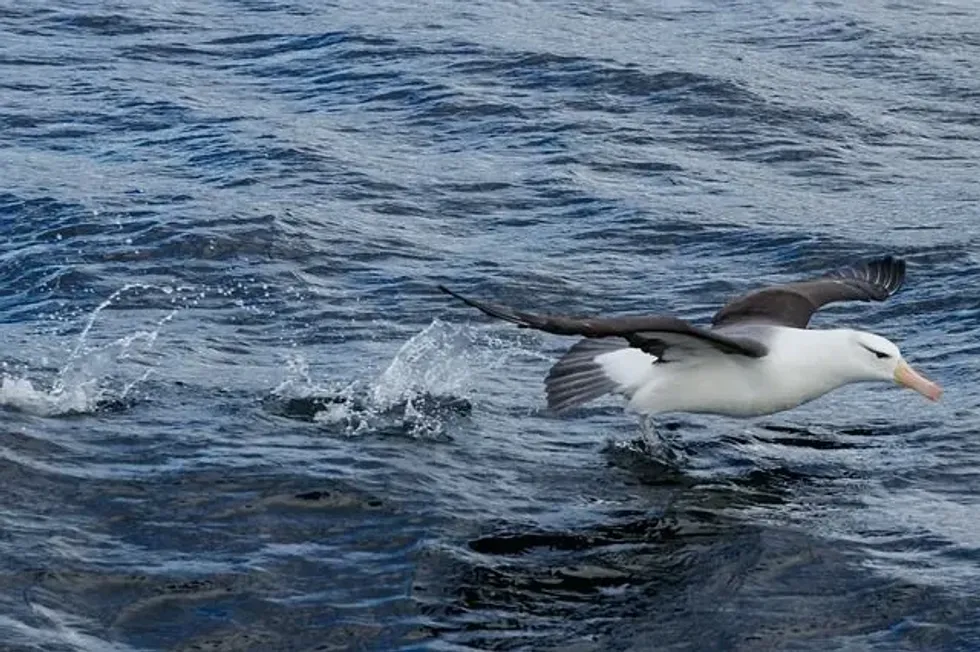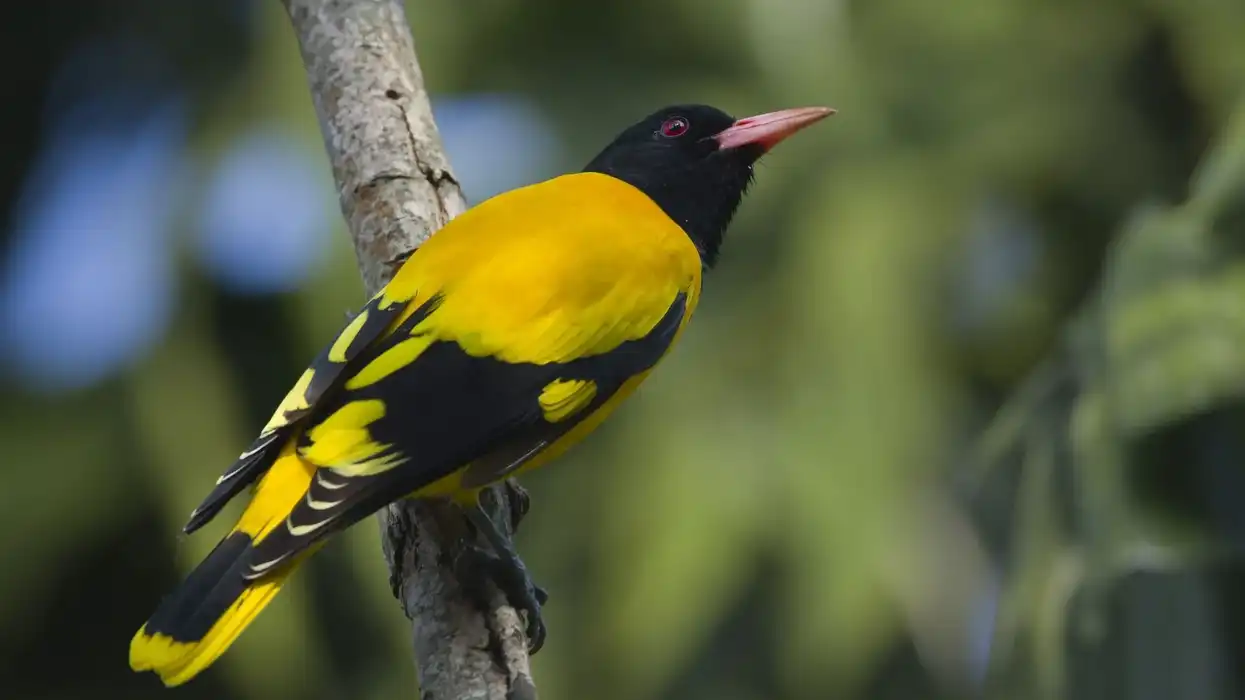The black-browed albatross (Thalassarche melanophris) belongs to the family of one of the largest seabirds, Diomedeidae. These seabirds are also known as black-browed mollymawk. Black-browed albatrosses are the most common and widespread member of their family.
They are a medium-sized albatross, with a length of 31–37 in (80-95 cm) and a pair of wings which are 78-94 in (200-240 cm) long. The average weight of a black-browed albatross is 6.4–10.4 lb (2.9-4.7 kg). This species has a lifespan of more than 70 years.
The name, black-browed albatross, comes from their dark eyestripes. This feature also distinguishes it from other mollymawks. The scientific name, Melanophris has been derived from two Greek words, 'melanos' and 'orphis' which mean 'black' and 'eyebrows', respectively.
A black-browed albatross' underwing is predominantly white and its margins are broad, irregular, and black. Dark underwings are also a feature of black-browed albatrosses.
The nostrils of black-bowed albatrosses are on the side of the upper bill, which is known as the naricorns. Their nasal passages are also attached to the naricorns. Black-browed albatrosses can be found in the Falkland Islands, Antarctic Peninsula, Cape Horn Islands, and South Georgia and the South Sandwich Islands in the southern oceans.
Keep on reading to learn more interesting facts about the black-browed albatross. If you want to know more exciting information about different animals, check out boreal chickadee and red bird of paradise facts too.
Black-Browed Albatross Interesting Facts
What type of animal is a black-browed albatross?
The black-browed albatross is a large seabird. It belongs to the albatross family Diomedeidae. Black-browed albatrosses are among the most spectacular glider birds. In windy weather, they can stay afloat for hours without flapping their wings. A black-browed albatross has a frowning appearance because of its dark eye streak.
What class of animal does a black-browed albatross belong to?
Black-browed albatrosses belong to the class of Aves and Thalassarche genus. This bird belongs to the family of one of the largest seabirds.
How many black-browed albatrosses are there in the world?
The population of black-brown albatrosses is decreasing in a few islands such as South Georgia Island and the Falkland Islands while the numbers are increasing in Greenland and on Heard Island.
Also, the International Union for Conservation of Nature has listed the species as Near Threatened and according to a report of 2005, the current population of this species is around 700,000 pairs.
Where does a black-browed albatross live?
A black-browed albatross is found in the vicinity of the southern oceans. The species is found primarily on the Falkland Islands, South Georgia, Campell Island, Crozet Island, and South Sandwich Islands during the breeding season.
What is a black-browed albatross's habitat?
Oceans and seas are the habitats of this black-browed mollymawk. The habitats of a black-browed albatross include the North Atlantic Ocean, the Pacific Ocean, Antarctic Peninsula, and the Indian Ocean. They usually migrate to several regions in the north but return to land during the breeding season.
Who do black-browed albatrosses live with?
Black-browed albatrosses are solitary at sea. During the breeding season, they gather in nesting colonies. Black-browed albatross nesting colonies can have more than 1,80,000 pairs. They are monogamous and black-browed albatrosses mate for life.
How long does a black-browed albatross live?
The average lifespan of black-browed albatross species is 32 years. Some birds even live for more than 70 years.
How do they reproduce?
These birds primarily follow the breeding practice of monogamy. A black-browed albatross nests on steep slopes or cliffs.
The breeding season lasts from September to April. The process mainly starts with the elaborate courtship behavior. They are quite colonial during the mating season and are majorly involved in making the nests out of seaweed, tussock grass, and guano.
A female bird lays only one egg and the incubation period lasts for around 70 days. The chick or the young bird is gray in color, and it takes around four months to develop wings and become large enough for a flight.
What is their conservation status?
The IUCN has classified black-browed albatross as Near Threatened. According to the IUCN Red List, there are around 700,000 pairs of black-browed albatross present currently.
Practices such as long-line fishing and trawl fishing are major causes for the decline in the population of these birds. Sailors primarily catch them for their meat and they also attack the colonies of nests for their eggs.
The population of breeding pairs is most affected in South Georgia near the Atlantic Ocean, and the Kerguelen Islands in the Indian Ocean.
Black-Browed Albatross Fun Facts
What do black-browed albatrosses look like?
These seabirds are best known for their beautiful black eyebrows. Medium in size, they are also known as black-browed mollymawks. Adult birds have a dark back and blackish-gray shoulder blades.
They have webbed feet to slow down their speed and use them like brakes. Young birds are dark gray in color. Oceans are the primary habitat of black-browed albatrosses and these birds are primarily found in the Falkland Islands, the Antarctic Weddle Sea, Cape Horn Islands, and South Georgia and the South Sandwich Islands in the south Atlantic.
How cute are they?
A black-browed albatross has a frowning appearance. However, they still are extremely cute. They have certain rituals and behaviors when they are with their mate. Black-browed albatross rituals include postures, rubbing bills, dancing, and calling. All of these make the black-browed albatross even cuter. Even the gray color of young birds makes them adorable.
How do they communicate?
Black-browed albatrosses are quite silent but communicate with one other in many ways. During the mating season, they communicate through courtship behaviors such as beak touching and preening.
Rubbing the bill of one another is also a practice of black-browed albatrosses. These birds also perform dances and calls to communicate with one another. Their sense of smell also helps them to become aware of their surroundings.
How big is a black-browed albatross?
The average weight and length of a black-browed albatross is 6.4–10.4 lb (2.9-4.7 kg) and 31–37 in (80-95 cm) respectively. This bird is almost thrice the size of the Auk birds which are major sea birds of North America. Also, this albatross species is twice the size of black-legged kittiwakes of North America.
How fast can a black-browed albatross fly?
These birds are one of the fastest species of sea birds. Primarily, the wind determines the speed of their flight. A black-browed albatross can reach a speed of more than 68 mph (110 kph). Also, young birds only become big enough for a flight after four months.
How much does a black-browed albatross weigh?
The weight of a black-browed albatross ranges from 6.4–10.4 lb (2.9-4.7 kg)
What are their male and female names of the species?
There is no specific name given to male and female black-browed albatrosses of this species.
What would you call a baby black-browed albatross?
No specific name is given to a baby black-browed albatross. They are simply referred to as chicks.
What do they eat?
Black-browed albatrosses are carnivores or piscivores, however they primarily prey on fish. The black-browed albatross diet includes crustaceans, fish, squid, and carrion.
Are they dangerous?
Black-browed albatrosses are silent birds who keep to themselves. They are not dangerous at all to humans and are mostly seen flocking with their own.
Would they make a good pet?
Black-browed albatross are quiet and silent birds and they do not require a complicated diet. These birds can be good pets if you are an experienced bird owner.
Ultimately, this bird is a wild animal and which enjoys flying long distances. Also, this bird is listed as Near Threatened so it is best if they are allowed to live in a wild habitat rather than in captivity.
Did you know...
Black-browed albatrosses have the ability to create oil in their stomachs. This is used to either spit on attackers or as a source of nutrients during long journeys.
Apart from humans, the major threats to these birds are tiger sharks, skuas, and rats.
In the past, albatrosses were killed for their feathers that were used in down and also in the fashion industry.
Which albatross has the largest wingspan?
The wandering albatross has the largest wingspan. The largest wingspan ever found on this species was around 12 ft (365 cm). These birds are also known as snowy albatrosses and are located in the Southern Ocean.
Can you find albatrosses in the UK?
These birds are primarily found in the regions of the Southern Hemisphere as the population of this species is constantly declining. However in the '60s, a black-browed albatross was spotted in the North of Scotland. It is believed that in 1967, this bird was diverted to the North Atlantic.
Here at Kidadl, we have carefully created lots of interesting family-friendly animal facts for everyone to discover! Learn more about some other birds including pink cockatoo, or Atlantic puffin.
You can even occupy yourself at home by drawing one on our albatross coloring pages.










